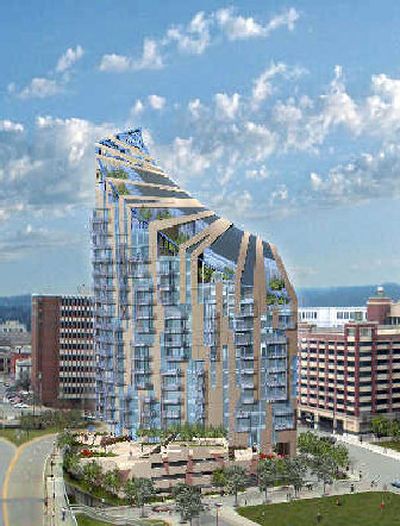Condos, outside of the box

CINCINNATI — Some buildings sweep to the sky in eye-catching twists and turns, while the mirrored exteriors of others reflect surrounding landscapes.
Visions by such celebrated architects as Michael Graves and Daniel Libeskind will likely change the skylines of many American cities, as developers increasingly turn to designers known more for their work on museums and other public buildings than condominiums and luxury housing.
Today’s structural stars are creating condos with curves, glass enclosed elevated walkways, glass expanses and other flourishes that in previous decades were reserved for office towers. Some in the architectural community see the burst of creativity as a renaissance in urban residential building.
“I think there is a new awareness in this 21st century that design is as important to where and how we live as it is for museums, concert halls and civic buildings,” says Libeskind, who designed the landmark Jewish Museum in Berlin and won the competition to create the master plan for the new World Trade Center in New York City.
Libeskind has designed a crescent-shaped, 21-story condominium complex — The Ascent — that will give the appearance of sweeping upward in a flourishing curve of mirrored glass against the backdrop of the Cincinnati skyline. Construction, which is expected to top $40 million, is to begin this year at along the Ohio River in Covington, Ky.
“Having a noteworthy architect’s name on a project also makes it unique and individual, so that if the market goes bad or softens up, we will be a notch above competitors,” says Craig Nassi, president of the Denver-based BCN Development LLC, which is building the 38-story Aura condominium in Sacramento, Calif.
In recent decades, urban condo design has largely tended to be more sedate and less imaginative than commercial office buildings and cultural institutions. Developers of residential buildings have often gone with designs that were more economical to build, especially as urban residents continued to migrate to the suburbs. While some cities such as San Francisco and New York have been innovative with urban loft spaces, much of the urban landscape has continued to be dominated by more traditional, often boxlike, brick apartment and condo dwellings.
“There was no heart or soul to it,” Ronnette Riley, chairwoman of the committee on design of the American Institute of Architects, says. “But in the last few years, there has been a shift with residents taking as much pride in the outside of buildings as in the inside.”
Also, the improvement in materials and technology has provided more opportunity for architects to design structures that even a few years ago might not have been possible, Riley says.
The demand for high-rise condominiums has increased as land becomes scarce and property values rise, and developers are looking for ways to make their buildings stand out in the urban residential market.
“Our region has come to grips with the future,” says Gary Stonehouse, Sacramento’s recently retired planning director. “We either could continue suburban sprawl or focus on more intense urban development. Eventually, you run out of land and freeway lanes.”
Developers count on the names behind what they hope will be eye-catching, finger-pointing designs: Libeskind; Graves, who designed the Walt Disney Co. headquarters in Burbank, Calif.; Richard Meier, known for the Getty Center; and Ralph Johnson, whose resume includes the Boeing World Headquarters.
Graves is designing a condominium hotel for Donald Trump in Fort Lauderdale, Fla., that will feature a curvilinear design and art deco windows, while Meier is doing the Beach House, a nearly all-glass structure in Miami Beach, Fla., and a new 16-floor condo tower in New York with an exterior of mostly glazed glass and steel. Johnson is the architect of the planned Signature Place, a 35-story complex of residential units and office and retail space to be built for $125 million in St. Petersburg, Fla.
“St. Petersburg was a fairly sleepy city until the last few years when condos starting popping up, but they were cookie-cutter buildings that all looked alike,” says project developer Joel Cantor, president and CEO of Cantor Communities.
The glass residential tower resembling a huge sail will soar above an attached five-story parking garage. The garage is topped by a landscaped park bigger than a football field and a pool that will create the illusion of a waterfall cascading down the side of the garage to a commons area below. Prices will range from around $350,000 to more than $4 million for the grand penthouse.
At Covington’s The Ascent, units go from about $395,000 for a single-bedroom condo to about $1.5 million for the penthouse, says Debbie Vicchiarelli, senior vice president for developer Corporex Cos.
The costs don’t seem to be keeping buyers away.
In Denver, at least 75 percent of the units in the Libeskind-designed Museum Residences were sold before construction began. In two Meier-designed condominium towers in New York, units are now resold for millions of dollars. The laminated glass and metal-paneled towers feature floor-to-ceiling windows that reflect the rippling waters of the Hudson River far below.
The projects are aimed especially at single professionals and baby boomers whose children have grown, such as Steve and Nancy Frank, who are considering moving to the Covington complex since their son has graduated from college.
“We no longer need a big house and the burden of maintaining it and a yard,” Steve Frank says. “At The Ascent, we would be within minutes of the symphony, art galleries, great restaurants and my office.”